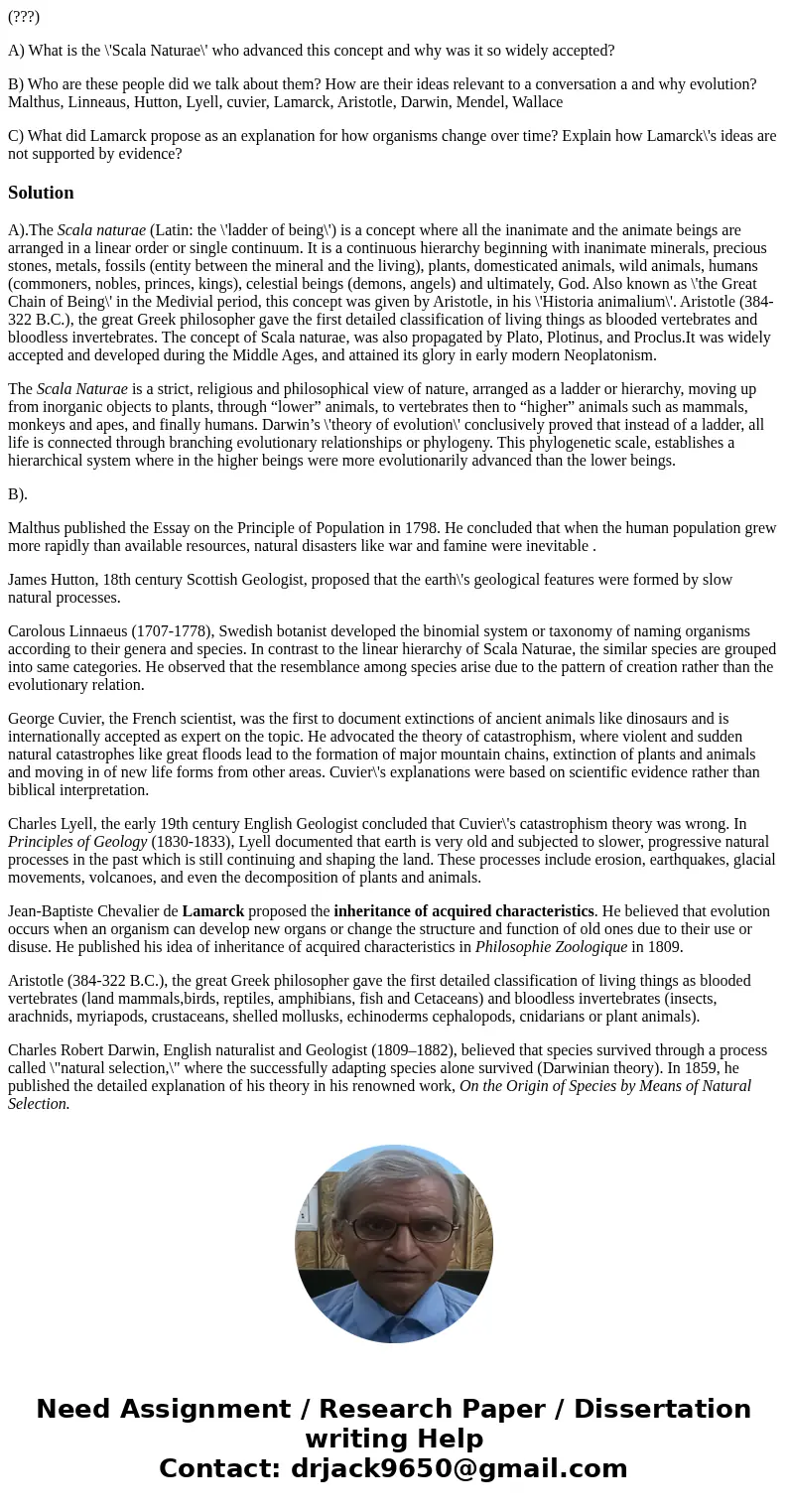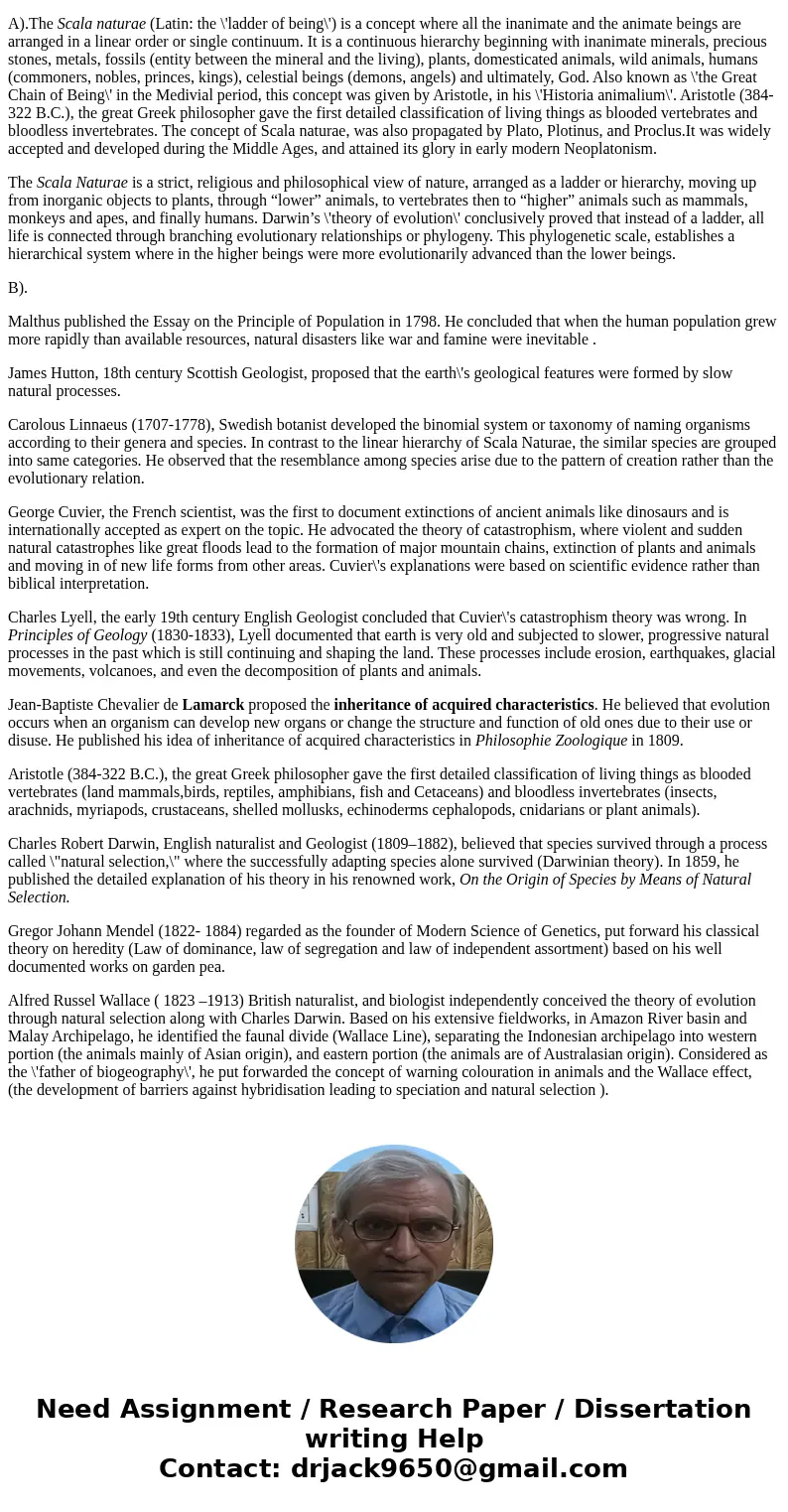A What is the Scala Naturae who advanced this concept and w
(???)
A) What is the \'Scala Naturae\' who advanced this concept and why was it so widely accepted?
B) Who are these people did we talk about them? How are their ideas relevant to a conversation a and why evolution? Malthus, Linneaus, Hutton, Lyell, cuvier, Lamarck, Aristotle, Darwin, Mendel, Wallace
C) What did Lamarck propose as an explanation for how organisms change over time? Explain how Lamarck\'s ideas are not supported by evidence?
Solution
A).The Scala naturae (Latin: the \'ladder of being\') is a concept where all the inanimate and the animate beings are arranged in a linear order or single continuum. It is a continuous hierarchy beginning with inanimate minerals, precious stones, metals, fossils (entity between the mineral and the living), plants, domesticated animals, wild animals, humans (commoners, nobles, princes, kings), celestial beings (demons, angels) and ultimately, God. Also known as \'the Great Chain of Being\' in the Medivial period, this concept was given by Aristotle, in his \'Historia animalium\'. Aristotle (384-322 B.C.), the great Greek philosopher gave the first detailed classification of living things as blooded vertebrates and bloodless invertebrates. The concept of Scala naturae, was also propagated by Plato, Plotinus, and Proclus.It was widely accepted and developed during the Middle Ages, and attained its glory in early modern Neoplatonism.
The Scala Naturae is a strict, religious and philosophical view of nature, arranged as a ladder or hierarchy, moving up from inorganic objects to plants, through “lower” animals, to vertebrates then to “higher” animals such as mammals, monkeys and apes, and finally humans. Darwin’s \'theory of evolution\' conclusively proved that instead of a ladder, all life is connected through branching evolutionary relationships or phylogeny. This phylogenetic scale, establishes a hierarchical system where in the higher beings were more evolutionarily advanced than the lower beings.
B).
Malthus published the Essay on the Principle of Population in 1798. He concluded that when the human population grew more rapidly than available resources, natural disasters like war and famine were inevitable .
James Hutton, 18th century Scottish Geologist, proposed that the earth\'s geological features were formed by slow natural processes.
Carolous Linnaeus (1707-1778), Swedish botanist developed the binomial system or taxonomy of naming organisms according to their genera and species. In contrast to the linear hierarchy of Scala Naturae, the similar species are grouped into same categories. He observed that the resemblance among species arise due to the pattern of creation rather than the evolutionary relation.
George Cuvier, the French scientist, was the first to document extinctions of ancient animals like dinosaurs and is internationally accepted as expert on the topic. He advocated the theory of catastrophism, where violent and sudden natural catastrophes like great floods lead to the formation of major mountain chains, extinction of plants and animals and moving in of new life forms from other areas. Cuvier\'s explanations were based on scientific evidence rather than biblical interpretation.
Charles Lyell, the early 19th century English Geologist concluded that Cuvier\'s catastrophism theory was wrong. In Principles of Geology (1830-1833), Lyell documented that earth is very old and subjected to slower, progressive natural processes in the past which is still continuing and shaping the land. These processes include erosion, earthquakes, glacial movements, volcanoes, and even the decomposition of plants and animals.
Jean-Baptiste Chevalier de Lamarck proposed the inheritance of acquired characteristics. He believed that evolution occurs when an organism can develop new organs or change the structure and function of old ones due to their use or disuse. He published his idea of inheritance of acquired characteristics in Philosophie Zoologique in 1809.
Aristotle (384-322 B.C.), the great Greek philosopher gave the first detailed classification of living things as blooded vertebrates (land mammals,birds, reptiles, amphibians, fish and Cetaceans) and bloodless invertebrates (insects, arachnids, myriapods, crustaceans, shelled mollusks, echinoderms cephalopods, cnidarians or plant animals).
Charles Robert Darwin, English naturalist and Geologist (1809–1882), believed that species survived through a process called \"natural selection,\" where the successfully adapting species alone survived (Darwinian theory). In 1859, he published the detailed explanation of his theory in his renowned work, On the Origin of Species by Means of Natural Selection.
Gregor Johann Mendel (1822- 1884) regarded as the founder of Modern Science of Genetics, put forward his classical theory on heredity (Law of dominance, law of segregation and law of independent assortment) based on his well documented works on garden pea.
Alfred Russel Wallace ( 1823 –1913) British naturalist, and biologist independently conceived the theory of evolution through natural selection along with Charles Darwin. Based on his extensive fieldworks, in Amazon River basin and Malay Archipelago, he identified the faunal divide (Wallace Line), separating the Indonesian archipelago into western portion (the animals mainly of Asian origin), and eastern portion (the animals are of Australasian origin). Considered as the \'father of biogeography\', he put forwarded the concept of warning colouration in animals and the Wallace effect, (the development of barriers against hybridisation leading to speciation and natural selection ).


 Homework Sourse
Homework Sourse